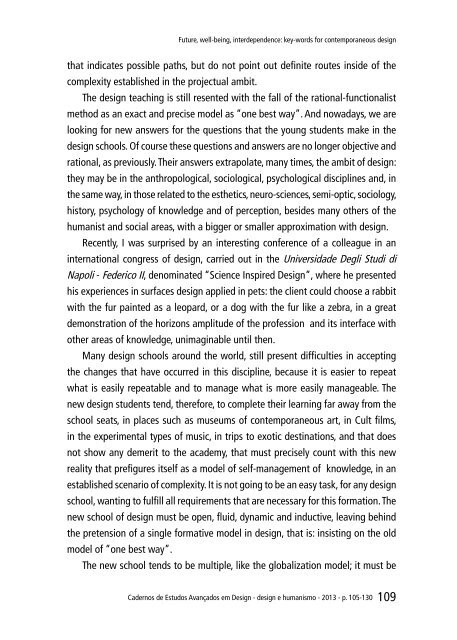o_19po8js951tvs1r0t1r8s4bb1vpla.pdf
Create successful ePaper yourself
Turn your PDF publications into a flip-book with our unique Google optimized e-Paper software.
Future, well-being, interdependence: key-words for contemporaneous design<br />
that indicates possible paths, but do not point out definite routes inside of the<br />
complexity established in the projectual ambit.<br />
The design teaching is still resented with the fall of the rational-functionalist<br />
method as an exact and precise model as “one best way”. And nowadays, we are<br />
looking for new answers for the questions that the young students make in the<br />
design schools. Of course these questions and answers are no longer objective and<br />
rational, as previously. Their answers extrapolate, many times, the ambit of design:<br />
they may be in the anthropological, sociological, psychological disciplines and, in<br />
the same way, in those related to the esthetics, neuro-sciences, semi-optic, sociology,<br />
history, psychology of knowledge and of perception, besides many others of the<br />
humanist and social areas, with a bigger or smaller approximation with design.<br />
Recently, I was surprised by an interesting conference of a colleague in an<br />
international congress of design, carried out in the Universidade Degli Studi di<br />
Napoli - Federico II, denominated “Science Inspired Design”, where he presented<br />
his experiences in surfaces design applied in pets: the client could choose a rabbit<br />
with the fur painted as a leopard, or a dog with the fur like a zebra, in a great<br />
demonstration of the horizons amplitude of the profession and its interface with<br />
other areas of knowledge, unimaginable until then.<br />
Many design schools around the world, still present difficulties in accepting<br />
the changes that have occurred in this discipline, because it is easier to repeat<br />
what is easily repeatable and to manage what is more easily manageable. The<br />
new design students tend, therefore, to complete their learning far away from the<br />
school seats, in places such as museums of contemporaneous art, in Cult films,<br />
in the experimental types of music, in trips to exotic destinations, and that does<br />
not show any demerit to the academy, that must precisely count with this new<br />
reality that prefigures itself as a model of self-management of knowledge, in an<br />
established scenario of complexity. It is not going to be an easy task, for any design<br />
school, wanting to fulfill all requirements that are necessary for this formation. The<br />
new school of design must be open, fluid, dynamic and inductive, leaving behind<br />
the pretension of a single formative model in design, that is: insisting on the old<br />
model of “one best way”.<br />
The new school tends to be multiple, like the globalization model; it must be<br />
Cadernos de Estudos Avançados em Design - design e humanismo - 2013 - p. 105-130<br />
109



